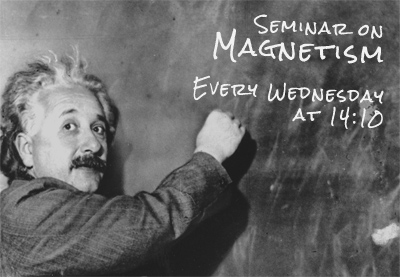Seminar on Magnetism
Group of Magnetism at the Department of Condensed Matter Physics
of Charles University and MGML has a pleasure to invite you to attend the joint seminar
on 20th March 2024 at 14:10
at Faculty of Mathematics and Physics of Charles University, Ke Karlovu 5, 121 16 Praha 2
Lecture room F2
Cinthia Antunes Corrêa
Institute of Physics of the CAS, Prague, Czech Republic
Crystal structure of the incommensurate composite structure of the misfit layer compound (PbS)1.11VS2
Cinthia Antunes Corrêa » Crystal structure of the incommensurate composite structure of the misfit layer compound (PbS)1.11VS2
Institute of Physics of the CAS, Prague, Czech Republic
Online link: cesnet.zoom.us Ask R. Colman for password.
Location: Lecture room F2, Ke Karlovu 5, Prague 2
Cinthia Antunes Corrêa1,2, Jiří Volný2, Klára Uhlířová2, Tim Verhagen2
1 Institute of Physics of the Czech Academy of Sciences, Department of Structure Analysis, Na Slovance 2, Prague, 182 00, Czech Republic
2 Faculty of Mathematics and Physics, Charles University, Ke Karlovu 5, Prague, 121 16, Czech Republic
The misfit material (PbS)1.11VS2 is a compound consisting of intercalating layers of the transition metal dichalcogenide (VS2) and monochalcogenide (PbS). The weak inter-layer van der Waals interactions and strong in-layer bonds allow for a slight twist of individual layers, creating an out-of-plane spontaneous polarization that leads to sliding ferroelectricity. Sliding ferroelectricity in two-dimensional materials has been recently shown theoretically [1] and experimentally [2]. However, most of it was observed on artificially prepared layered materials by stacking the exfoliated layers with a slight twist between them. (PbS)1.11VS2 naturally grows as a stacking of the TMD and TMM, forming a van der Waals superlattice.
In this work, (PbS)1.11VS2 was grown by chemical vapor transport and is stable at ambient conditions. The crystal structure was elucidated using single-crystal X-ray diffraction and is an incommensurate modulated composite with the layers stacked along the c-axis. The interaction between the two subsystems works as a perturbation potential that generates satellite reflections on the diffraction patterns. Intrinsic twin formation with a relative rotation of less than one degree leads to sliding ferroelectricity at room temperature. Triangular and lamellar ferroelectric domains vary from a few nanometers to tens of micrometers. We will present the crystal structure of (PbS)1.11VS2 using the superspace formalism for a composite structure.
References:
[1] L. Li and M. Wu, ACS Nano 11 (6), 6382-6388 (2017)
[2] D. Zhang et al., Nature Reviews Materials 8, 25-40 (2023)


